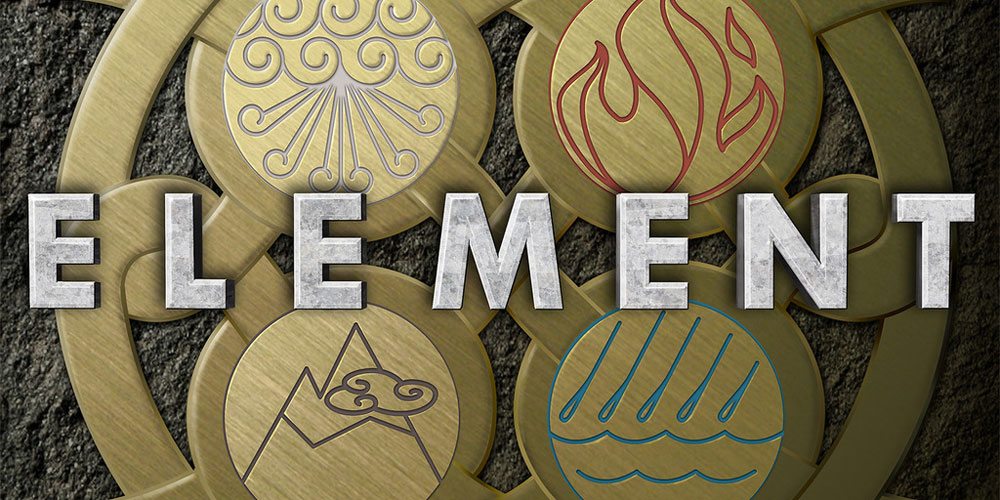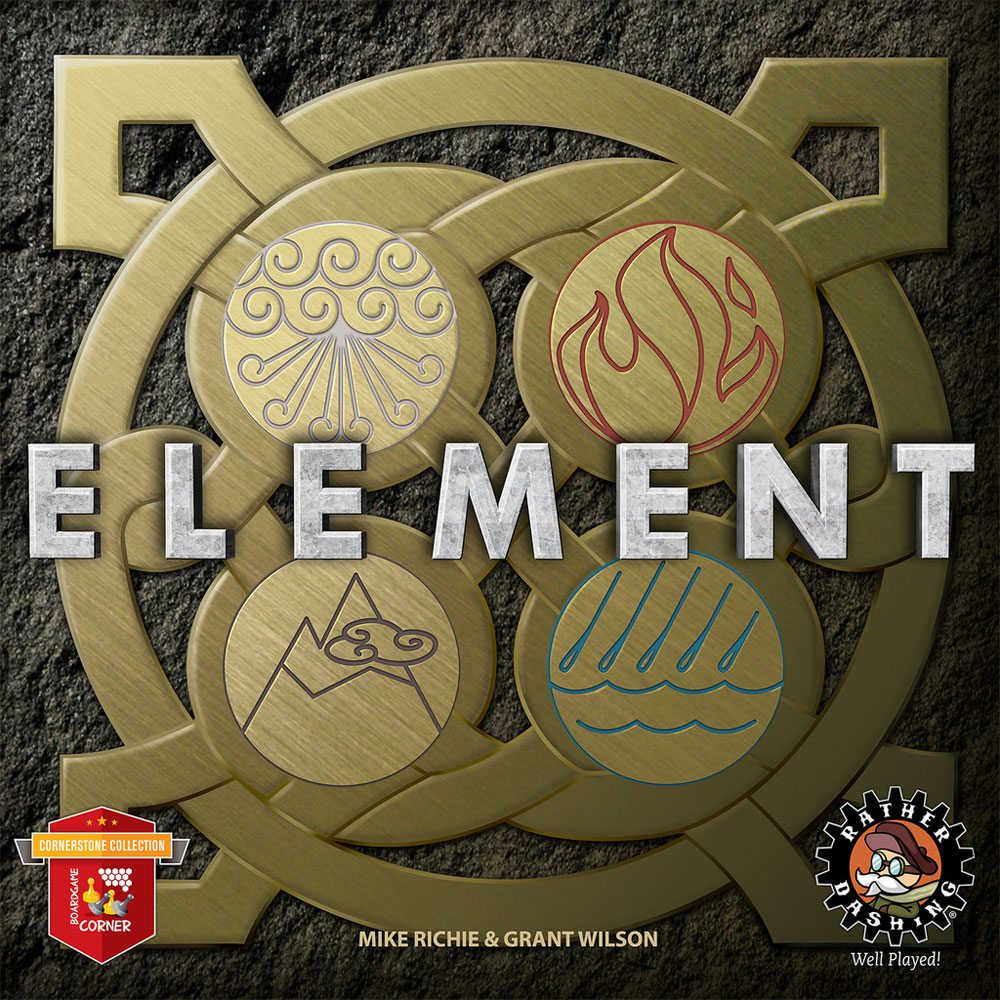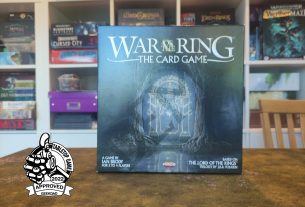Fire, Water, Earth, Wind—can you master the four elements before the other sages? Manipulate the elements, from raging fires to impassable mountains, to encircle your opponents and free yourself.
At a glance: Element is an abstract strategy game by Mike Richie and Grant Wilson for 2 to 4 players, ages 14 and up, and takes 30–60 minutes to play. It retails for $34.99 and will be released March 1. (Amazon has it available for preorder with a March 15 release date.) The game has nothing inappropriate for younger kids, so could be played by kids as young as 8 0r 10 as long as they enjoy abstract strategy games.
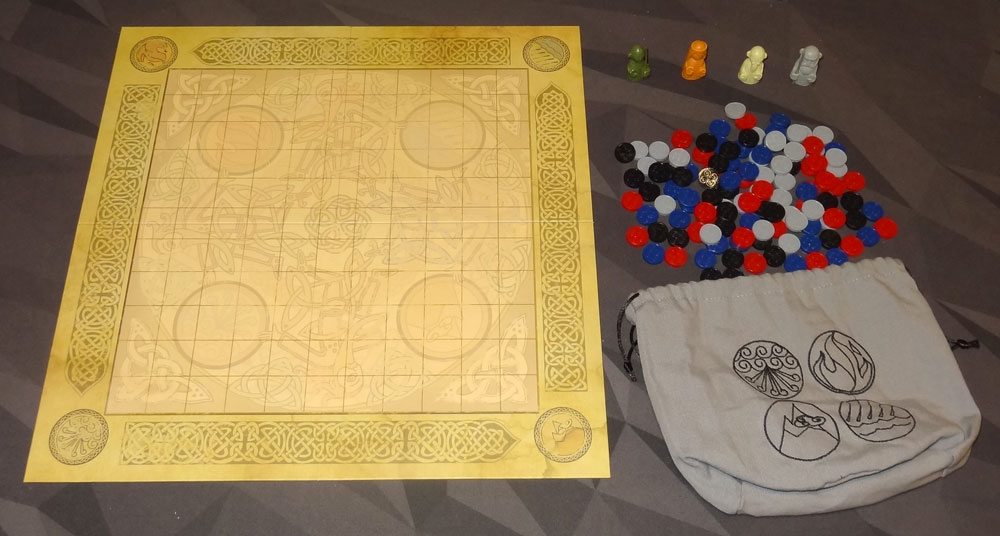
Components
- Game board
- 4 Sage figurines
- Cloth bag
- 120 Element stones (30 each in red, blue, black, grey)
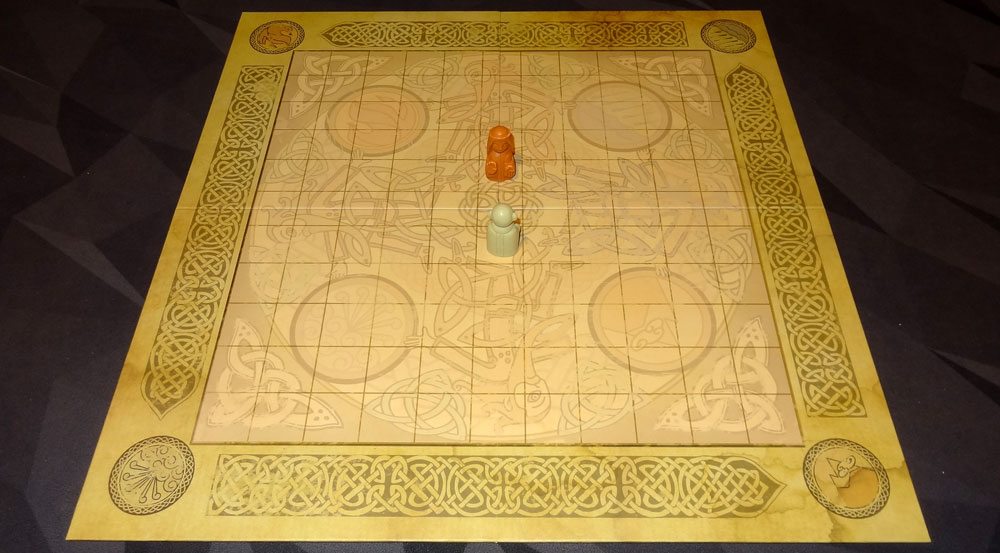
The board has a muted Celtic-inspired illustration on it, overlaid with a simple grid. Other than the four element circles, which serve as starting spaces in 3- or 4-player games the illustration doesn’t have any particular gameplay effect. The outer edge of the board has the four elements in the corners, with decorative knotwork borders—these actually do serve as a reminder of the order in which elements can replace each other.
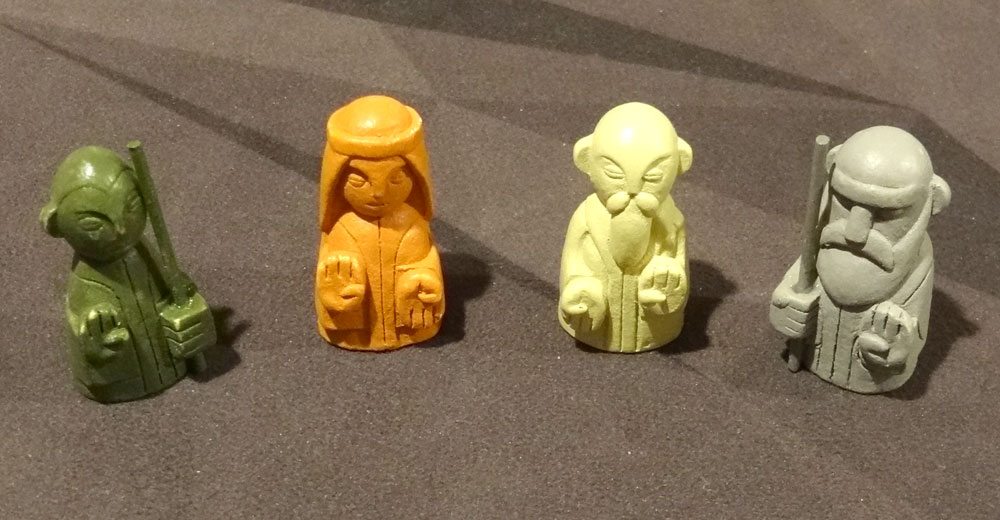
The sages themselves are very cool, and my favorite components in the game. I don’t actually know what they’re made of, because they feel heavier than wood or plastic—perhaps some sort of painted clay. I can see that a little bit of paint is wearing off some portions (like the green sage’s fingertips and knuckles) and it’s pale underneath. But they have a nice heft to them, and the style makes them look like pieces recovered from some ancient game. I also like how most of them look so peaceful and unassuming, even though you’re going to be flinging elements at each other.
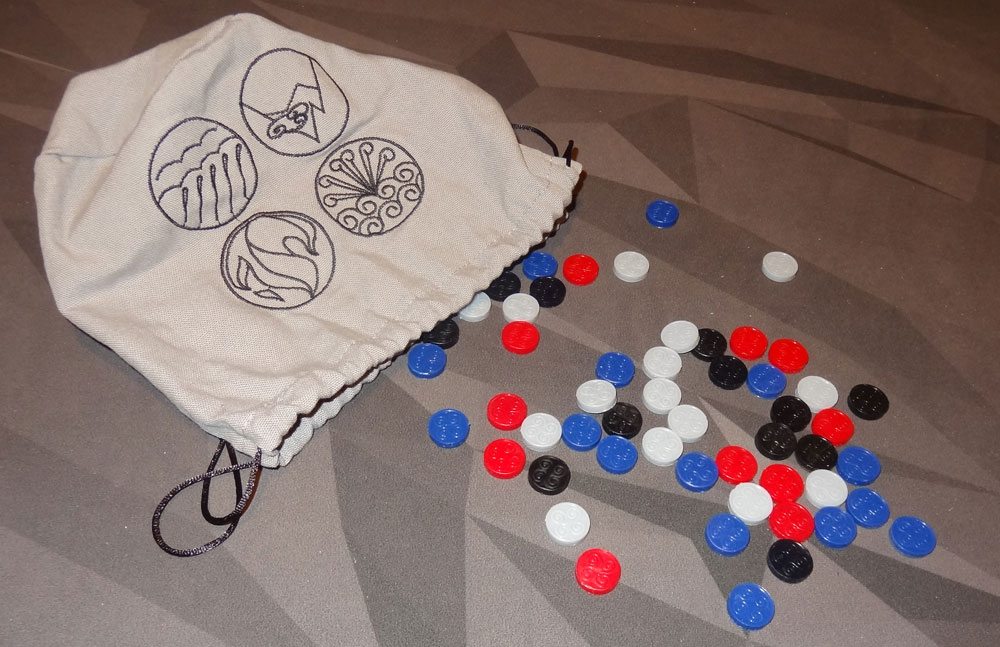
The cloth bag is a nice, large drawstring bag with a flat bottom and the four elements embroidered on it. It’s pretty large—much bigger than needed to hold the small stones, but it means there’s plenty of room to reach your whole hand into the bag when drawing stones. My cloth bag smells a little funny—some sort of chemical odor—though perhaps that will dissipate over time.
The “stones” are small plastic discs. Each one has a simple pattern of four swirls on it. I kind of wish they had the different elements on them—after all, the board has special icons for each element—but I can understand that tooling four separate molds would have significantly increased the cost of the game. I also wish the stones came in slightly more naturalistic colors—you can see that the sages and the board use a lot of earth tones, but the red (fire) and blue (water) stones are bright primary colors and don’t seem to fit quite as well.
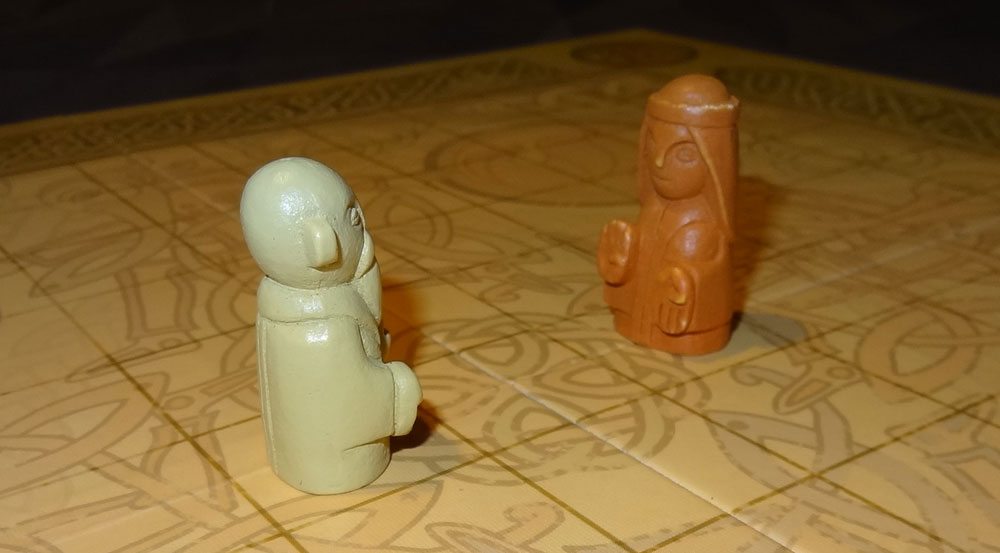
How to Play
You can download a copy of the rules here.
The object of the game is to trap your target by surrounding them with stones (or against the edge of the board) so they cannot move. In a 3- or 4-player game, your target is the player to your right.
At the beginning of the game, each player takes a sage and places it in a starting space. In a 2-player game, the two sages start opposite each other next to the center space. In a 3- or 4-player game, the sages start in the element circles on the grid. Choose a starting player and then play continues counter-clockwise.
On your turn, you may draw up to 4 element stones from the bag, and you may move your sage 1 space. If you choose to draw fewer stones, you may move your sage 1 additional space for each stone forfeited—however, you must decide how many stones to draw at the beginning of your turn. Unused movement and stones do not carry over.
You may move your sage in any direction (including diagonally) but you may not move into spaces with other sages, or with fire, water, and earth stones. Wind stones are a special case—I’ll explain those later. You may place stones and use your movement in any order.
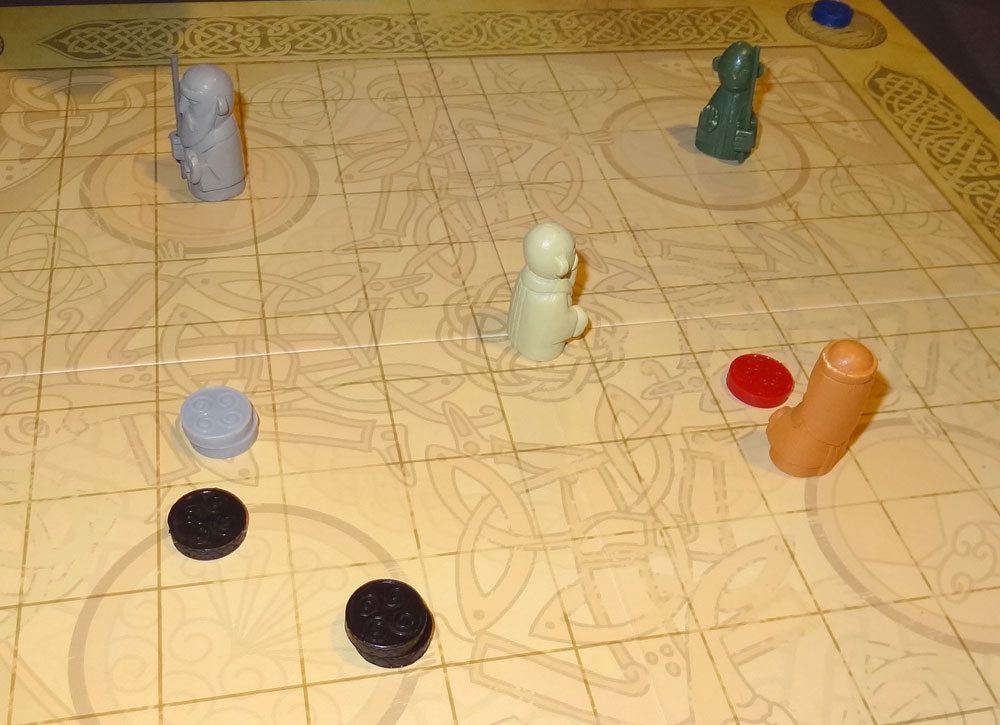
A stone may be placed on any empty space, or to replace an element following the Rule of Replacement (which is also indicated by the border of the game board): water replaces fire, fire replaces wind, wind replaces earth, and earth replaces water. In addition, every element has its own unique effects.
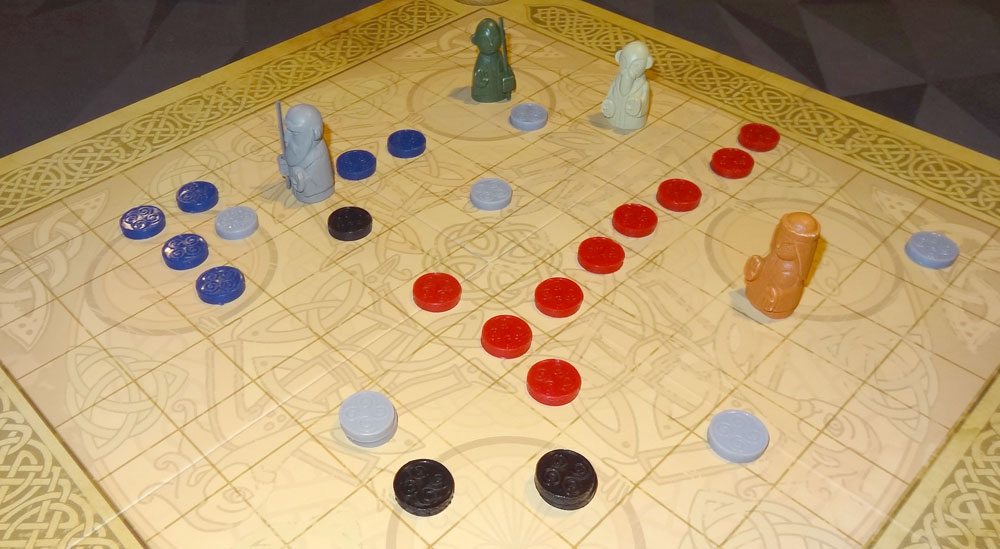
Fire: when you place fire next to existing fire, it spreads more fire to the other side of the piece or line of fire. Placing it adjacent to multiple fires can cause fire to spread in multiple directions at once.
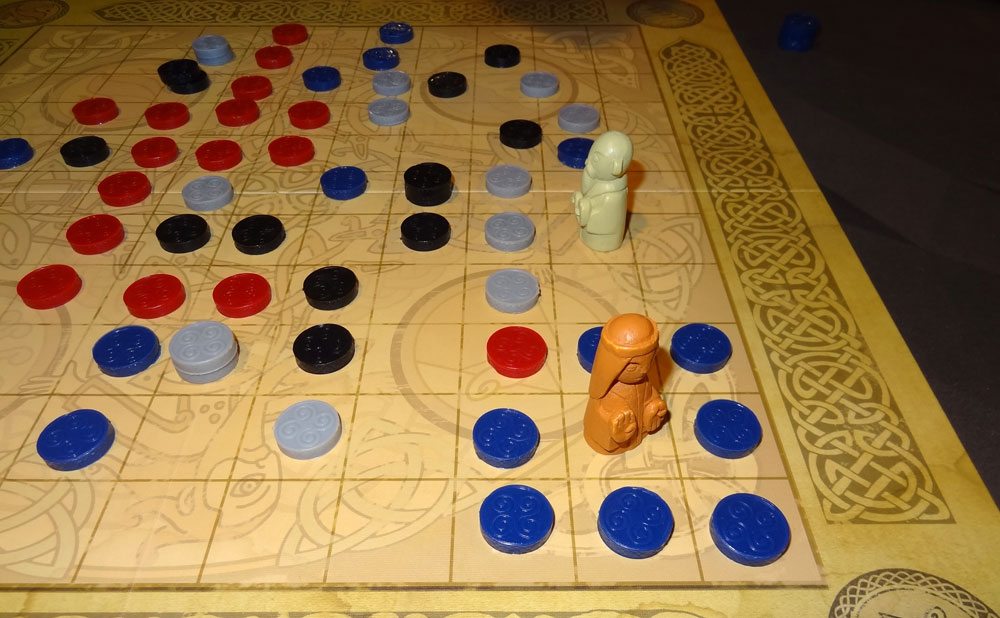
Water: when you place water next to existing water, it becomes a river—the entire straight line of water will flow in the direction of the piece you just placed, as many spaces as the length of the line. The river can change direction while flowing, but it must have room to carry out its entire movement, or you cannot place the water there.
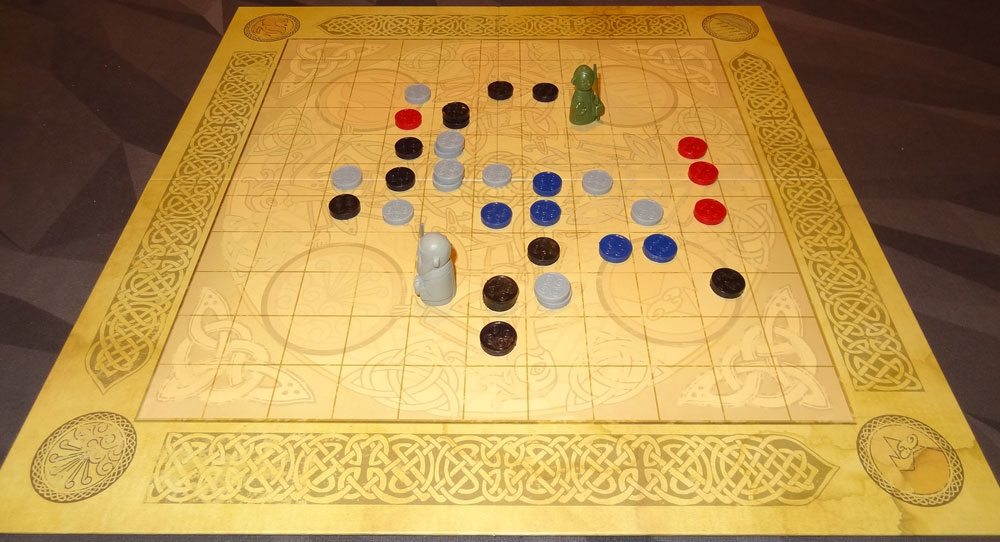
Earth: an earth stone can be stacked on top of another, creating a mountain that can no longer be replaced by wind. In addition, any earth stones connected orthogonally or diagonally to the mountain also become part of an impassable mountain range. Usually, you can move diagonally between two pieces, but a diagonal mountain range blocks movement.
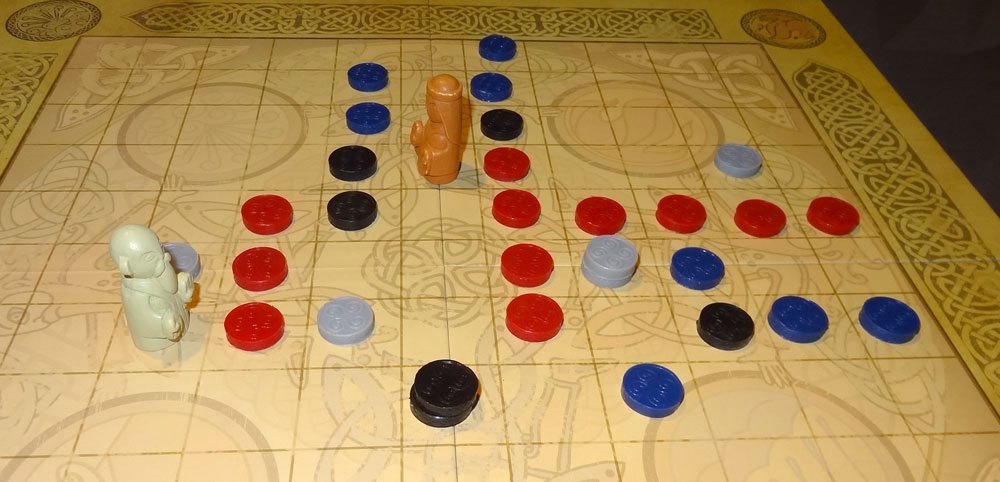
Wind: unlike the other elements, wind lets you jump over it for free (not using your movement allowance). Wind can be stacked up to 4 high, and jumping over a stack of wind tiles will let you skip a number of spaces equal to the height—as long as you can land in an empty space. An entire stack of wind can be replaced by a single fire stone.
The game ends when a sage has been surrounded and cannot move—whoever was targeting that sage wins the game.
The Verdict
Element is an abstract strategy game, but it does use the four elements for thematic effect. My family has finally started watching The Legend of Korra, so I can imagine the sages are like Avatars with the ability to bend all four elements. (Why are there four Avatars at once? Well…) I like the way that each element behaves differently when placed, so that they’re not just equivalent stones with different colors.
Although there are particular starting positions, there isn’t really a section of the board that is “yours.” You and your opponents share the entire board and can move around anywhere—which means that if you set up a dead end trap, your opponent may be able to spring it on you if you’re not careful. Early in the game, the board is wide open and you don’t really feel in danger of being pinned down, since you can usually use some elements to replace others (except mountain ranges, which cannot be removed). Or, you can always draw fewer stones so you can move a little further. Wind stones also make for easy exits, as long as nothing is blocking your destination space.

Once the board starts to get crowded, though, you’ll have to be more careful. Do you take a chance on drawing stones, hoping you’ll get the ones you need to ensnare your opponent? Or do you guarantee that you can move five spaces to get away from that growing mountain range? Do you spend your water stones to wash away the fire near you, or try to enclose your opponent with a river? And, of course, it’s important not to stay on the edge of the board too long, because you’re already up against a wall there.
Playing with more than two players introduces an interesting aspect, where you’re chasing one player and a different one is chasing you. In this case, you may be able to make use of stones played by multiple opponents to trap your own quarry. At times, you may even want to help another sage get away from a sticky situation because if they get trapped, somebody else wins.
Since you’re drawing stones out of a bag, it’s not a game of pure strategy like chess or Go—there’s definitely an element of luck to it. If you’re counting on a wind stone to jump over a mountain range, you can choose to draw all four stones for a better chance of drawing wind, but you’ve got no guarantee. So you’re making tactical decisions based on imperfect information and probabilities. For gamers who value skill and strategy above luck it may feel less rigorous, but that element of chance may be appealing to others (and gives less-experienced players a chance against more-experienced players).
I only have two complaints about the game. The first I already mentioned: the stones seem a bit cheap (in look and feel) compared to the rest of the components—they’re small and very light plastic, and so they don’t have as satisfying a feel as wood discs would. But, really, it’s only in contrast to the high quality of the rest of the components that the element stones seem inadequate. Also, while the rulebook is nice to look at, I feel that there were some questions (particularly about the wind-jumping) that were not explained very clearly, so I did have to refer to some FAQs online to get answers about some specific situations.
That said, the gameplay itself is a lot of fun, and you can pretend you’re an Avatar, bending the elements to your will and turning them against your opponents. Look for Element in stores next week!
Disclosure: I received a review copy of this game.
